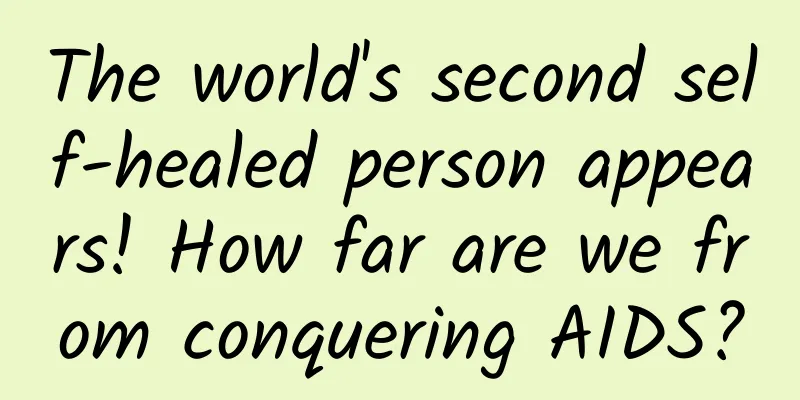The world's second self-healed person appears! How far are we from conquering AIDS?

|
December 1 is the 34th World AIDS Day. Recently, the world's second self-healing patient appeared! Why can HIV-infected patients recover on their own? How far are we from conquering AIDS? December 1, 2021 is the 34th World AIDS Day, and this year's theme is "Life First, End AIDS, Health Equality". The latest data shows that as of the end of 2020, more than 1.05 million people in China were infected with HIV. At the same time, the infection rate in some populations has also increased significantly. ▲The 34th "World AIDS Day" promotional poster on December 1, 2021 (Photo source/National Health Commission official website) This year marks 40 years since the first case of AIDS was reported worldwide in 1981, but the disease is still prevalent in human society. On November 16, 2021, a paper in the famous medical journal Annals of Internal Medicine confirmed that the Ragon Institute of Massachusetts General Hospital, MIT, and Harvard in the United States had discovered the world's second HIV-infected person who had self-healed without treatment. To protect privacy, researchers named the woman "Esperanza Patient" after the small town in Argentina where she lived. Why can HIV-infected people heal themselves? Can scientists discover the secret behind self-healing? How far are we from conquering AIDS? ▲The Annals of Internal Medicine published an article titled "A possible method to cure HIV-1 infection without stem cell transplantation" (screenshot of the Annals of Internal Medicine article) The impossible is possible: Miraculous self-healing In March 2020, in Esperanza, northeastern Argentina, a man was pacing anxiously downstairs of the hospital. Like other anxious husbands, this young man had been waiting outside the building for several hours. The difference was that what he was looking forward to was not a newborn, but a special gift from life - a fresh placenta from a pregnant woman. In a few hours, he will take this fresh placenta sample and cross the blockade of the epidemic to Buenos Aires. There, several scientists are also anxiously looking forward to the nearly 500 million living cells provided by this sample to create another miracle in the fight against AIDS. The patient who provided the placenta sample was a 30-year-old woman from Esperanza. In 2013, her ex-boyfriend was diagnosed with AIDS, and she was diagnosed shortly afterwards. However, unlike her ex-boyfriend who died four years after becoming ill, this woman's behavior was unusual: since her diagnosis, she had not shown any symptoms, and no evidence of viral survival or replication was detected in her body. The only indication that she had been infected with HIV was the presence of antibodies in her body. During the eight-year follow-up after diagnosis, researchers were surprised to find that not only was the patient's viral load test results below the threshold every time, but she had never received conventional drug treatment and only took antiretroviral therapy (ART) for 6 months by taking medication during her pregnancy in 2019. In March of the following year, after the woman successfully gave birth to a healthy HIV-negative newborn, scientists retested the woman's placenta, an organ loaded with a large number of maternal immune cells, and once again obtained an exciting result: no HIV-1 virus was detected. ▲A row of empty squares and circles means "not detected" (Source: A Possible Sterilizing Cure of HIV-1 Infection Without Stem Cell Transplantation) The researchers said that after analyzing nearly 1.2 billion peripheral blood mononuclear cells from patients and more than 500 million mononuclear cells from placental tissue, they were unable to find any complete HIV viral genome. In the virus growth test, they did not detect HIV-1 viruses with replication ability in 150 million inactivated CD4+T cells. At the same time, the researchers not only detected a fairly complete hypermutated provirus, proving that the HIV virus must have replicated in the patient's body, but also found genetic evidence that fully proved that the virus had undergone multiple rounds of replication and attenuation. In other words, this "Esperanza patient" was indeed unfortunately infected with the HIV virus, but fortunately, she miraculously recovered. Today, this lucky woman knows that she is "special". She told the media, "When I realized that my illness is of great significance to the fight against AIDS, I also felt a great sense of responsibility." She does not want people to know her name. She and her husband are also confident about the future - they are considering giving birth to a second new life. The world's second "super elite" appears "What I'm very curious about is what happened to this patient in the first few days and weeks after infection," said Stephen Dicks, a professor of medicine at the University of California, San Francisco and a well-known AIDS researcher. In his opinion, based on the current results, for some reason, the body of "Esperanza Patient" did not produce all types of HIV antibody proteins like most AIDS patients, but instead activated natural immunity, preventing the virus from replicating long before the virus spread and invaded her immune system. As for what these reasons are, it is still unknown. "Usually this only happens if the patient starts taking antiretroviral drugs very early," Dix said. In fact, the reason why AIDS is difficult to completely cure is that the HIV virus "inserts" its own genome into the genome of human cells. In this state, HIV can effectively evade drugs and human immune responses, and will continue to produce new viruses. Although ART and other therapies can prevent the production of new viruses, they cannot completely eliminate them. This is why AIDS patients need to take medication for life. However, as the number of AIDS patients continues to grow and people's understanding of AIDS deepens, researchers have found that a very small number of patients can suppress HIV without medication and rely solely on their own immunity. Although their virus tests are positive, they have never had symptoms and the virus level in their bodies is always very low, achieving "functional cure." These lucky patients are called "elite controllers," accounting for less than 0.5% of the more than 38 million AIDS patients worldwide. Obviously, the "Esperanza patient" is also an elite controller, but the difference is that most people only achieve "functional cure", that is, they cannot eradicate the virus and can only maintain a low load, but she has achieved "clearance cure" - no complete HIV virus sequence can be detected in the body. Before this, there was only one patient in the world who was discovered in August 2020. Like the "Esperanza patient", this patient, code-named "San Francisco patient", not only never took medicine in the 25 years since her diagnosis, but researchers also did not detect a complete HIV virus sequence in her body. ▲"San Francisco patient" Lorraine Willenberg (right) participated in a discussion on HIV treatment (Source: UMA) Why did the "Esperanza patient" and the "San Francisco patient" have such strong bodies? Unfortunately, the answer to this question has not been revealed to this day. "If we can compare her (Esperanza patient's) DNA or immune cell gene expression with other people, maybe we can find something interesting," said Dix, even though he himself knows that this wish is more of a pipe dream: for the human immune system, many of the "participants" involved in genetic response are transient molecules. It is almost impossible to know what happened in the body of "Esperanza patient" at a certain period of time more than ten years ago, or even to trace the root cause decades later. The recovered and the unrepeatable story For the vast majority of AIDS patients, taking medication for life and coexisting with the virus is an almost irreversible fate. However, there are exceptions to everything. In addition to the "San Francisco patient" and "Esperanza patient" who achieved self-healing, there have been patients in human history who have achieved "clearance cure" through treatment. The world's first "cured" AIDS patient was codenamed the "Berlin Patient." His cure was both unfortunate and fortunate: Like most AIDS patients, the "Berlin Patient" was found to be HIV positive in 1995, but because he took medication early, his condition was under very good control. However, as if it weren't bad enough, the "Berlin Patient" unfortunately developed acute myeloid leukemia in 2006. Since then, doctors have been treating him with chemotherapy for leukemia rather than HIV. After repeated infections and recovery, doctors recommended a bone marrow stem cell transplant. Fortunately, the "Berlin patient" not only found a suitable bone marrow, but the sample also had a mutated CCR5 gene. It turns out that CCR5, as a protein receptor, has always played the role of an accomplice - it can help HIV virus enter immune cells. However, because of the missing code, the mutated CCR5 gene not only can no longer play the role of "guide", but has become a threshold that HIV virus cannot bypass, becoming a solid safety barrier. After 60 failed experiments, the "Berlin patient" received a bone marrow transplant in February 2007 and truly got rid of the HIV virus - researchers could not detect HIV virus sequences in his blood! Like the "Berlin patient", the second "London patient" who was cured of HIV also received a bone marrow transplant, and his partner also had a rare CCR5 variant gene. ▲"Berlin Patient" Timothy Brown (Photo source: BBC) The success of curing AIDS, which is theoretically incurable, is certainly gratifying, but is it universal enough? The fact is quite the opposite: bone marrow transplantation is an extremely risky operation, because the strong graft-versus-host reaction it causes has a high mortality rate. As the attending physician of the "London patient", Ravindra Gupta, an immunology expert at University College London and a well-known HIV biologist, believes that this treatment is not only expensive and complicated, but also has many variables and is not suitable for all patients. Previously, researchers had used the same method to test treatment on AIDS patients with leukemia, but the final results were not optimistic: the patients either died of leukemia, or died of complications caused by stem cell transplantation, or the body could still detect the presence of HIV virus... New hope or new mystery? Although "curing" AIDS is a seemingly impossible challenge, and although there are still many mysteries about the two "super elites" who successfully cured themselves, it is gratifying that as scientists discover more elite controllers and figure out how their bodies effectively suppress the HIV virus, it will also help the vast majority of AIDS patients around the world. "We found that the location of the viral genome in the elite controllers' bodies (DNA) is very atypical," said Professor Yu Xu, an immunologist at Harvard Medical School. As the leader of a collaborative project between Harvard and MIT's Ragon Institute for Medical Research, Xu has been committed to studying the elite controller group of AIDS patients. The discovery of the two "super elite" patients is the result of long-term tracking and observation by Xu's team. ▲Professor Yu Xu, an immunologist at Harvard Medical School (Source: Boston Globe) In the study, Xu Yu and his team were surprised to find that the genomic location of the HIV virus in the elite controllers is usually a very inactive location called a "gene desert". Here, human DNA will never be "activated" - meaning that these HIV viruses will be firmly "locked" in the cell's genome and cannot be used to replicate and produce more viruses, so they will not cause disease. In fact, despite the discovery of the "San Francisco patient" and the "Esperanza patient", Xu Yu's attitude is still cautious. In the published article, Xu Yu admitted that the discovery of the "Esperanza patient" was exciting, but it did not mean that she was completely cured - they could not sequence every cell in the patient's body, and they could not guarantee that there was no active virus in it. At the same time, considering that the patient did receive short-term drug treatment during pregnancy, people could not rule out the possibility that the drug was effective. Similarly, Natalie Laufer, a researcher at the Buenos Aires Institute for Biomedical Research on Retroviruses and AIDS and the attending physician of the "Esperanza patient," also believes that although scientists in the field of AIDS can never say "cure", more and more evidence is showing that "complete control" is very possible for some individuals. "The emergence of patients who can recover on their own has changed the paradigm of human treatment of AIDS," she said. Prior to this, the "cocktail therapy" proposed by Professor David Ho has always been recognized as the best treatment for AIDS. For the "San Francisco patient" and "Esperanza patient" who "recovered without treatment", they are likely to have a specific killer T cell response. If scientists can develop a more universal treatment based on this magical immune mechanism, it will also be expected to help the vast majority of AIDS patients completely eliminate the virus and achieve a true cure. References Distinct viral reservoirs in individuals with spontaneous control of HIV-1. Nature, 2020.9. A Possible Sterilizing Cure of HIV-1 Infection Without Stem Cell Transplantation.2021,11 Written by reporter Wang Xueying, Photo and text editor Chen Yongjie New Media Editor/Lv Bingxin Produced by: Science Central Kitchen Produced by: Beijing Science and Technology News | Science Plus Client Welcome to share to your circle of friends Reproduction without authorization is prohibited |
<<: Did you know? After HIV infection, you actually have 72 hours to save yourself
>>: How much do you know about the new drugs in 2021?
Recommend
How to monetize community operations? 8 major community monetization models!
Many people engage in community operations with t...
Why can't elephants grow tusks anymore?
Vocabulary reproduce disappear proportion weed ou...
After a successful launch, where does the rocket's final stage go?
"10, 9, 8, 7, 6, 5, 4, 3, 2, 1, ignition&quo...
Do you believe that Android users can use Apple Maps?
Since its launch, Apple Maps has been criticized ...
Case analysis | Lagou Education’s Double 12 1-yuan flash sale
From the perspective of the historical context, t...
This place is much more interesting than Pandora...
Tadpole Jun guessed that the most exciting thing ...
After two months in the job, I would like to share my new experience on product operation and promotion!
After joining the new company, I had the opportun...
How big is the difference between bottled water that costs 1 yuan, 2 yuan, and several hundred yuan?
Expert of this article: Pan Jingwen, Assistant En...
Happy Notes_Life Structured Training Camp Course Sharing Baidu Cloud Download
Happy Notes_Life Structured Training Camp Course ...
How can activities attract more users? I summarized these 4 key points
When running events or conducting marketing activ...
The more an ad looks like information, the more likely it is to be clicked? Please stop hurting your users.
There is a saying in current information flow ads...
17 psychological phenomena that planners and promoters must know in 2020
Consumer insights , which marketers often talk ab...
Where did all those guys who made routers last year go?
In October 2013, Lao Wang contacted Zhai Kejun thr...









